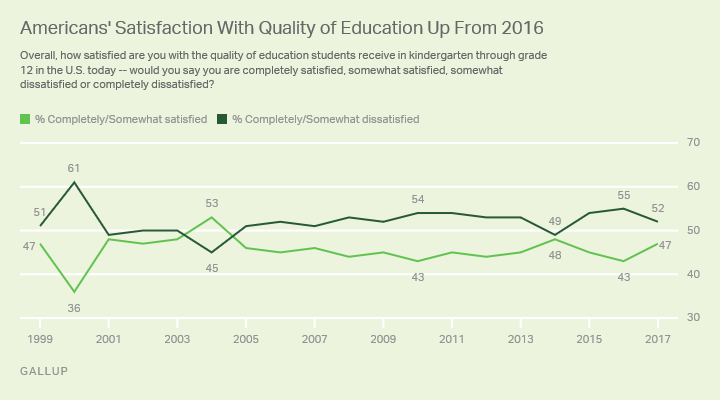Story Highlights
- 47% are satisfied with K-12 education nationwide; 52% dissatisfied
- Democrats are more satisfied than Republicans with education in U.S.
- 79% are satisfied with the state of their own child's education
WASHINGTON, D.C. -- Americans are more satisfied this year with the quality of U.S. K-12 education than they were last year, but a majority remain dissatisfied. Forty-seven percent currently say they are "completely" or "somewhat" satisfied, and 52% say they are completely or somewhat dissatisfied, compared with 43% satisfied and 55% dissatisfied last year.

Although satisfaction recovered this year from a downtick in 2016, the current 47% is on par with where it has been for the past 12 years. Since Gallup began asking this question in 1999, U.S. adults generally have been more likely to say they are dissatisfied than satisfied with the state of K-12 education, with satisfaction levels typically in the 40% to 50% range. The major exceptions were in 2004 -- after George W. Bush launched the education initiative "No Child Left Behind" -- when more Americans were satisfied than dissatisfied, and in 2001 and 2014 when satisfaction and dissatisfaction were nearly tied.
Republicans Causing Uptick in U.S. Education Satisfaction
Republican satisfaction with K-12 education jumped 11 percentage points in Gallup's Aug. 2-6 Work and Education poll, climbing from 32% to 43% in the past year. This is the highest Republican satisfaction level since 2014, when they tied Democrats at 48%. Democrats' views are largely unchanged since 2016, meaning the jump in sentiment among GOP supporters has driven the increase in satisfaction overall.

Republicans may be more satisfied this year because a Republican president is in the White House. During the Barack Obama years, Democrats' satisfaction tended to be on par with or higher than satisfaction among Republicans. The reverse was mostly true during George W. Bush's presidency, when Republicans and Republican-leaning independents tended to be more satisfied than Democrats and Democratic-leaning independents. While the high-water mark for Republican satisfaction occurred in 2004, Democrats' high point was in 2016 (53%) during Obama's final year in office.
Parents Satisfied With Quality of Child's Education
Parents of school-aged children are much more satisfied with their own child's education than Americans are with U.S. K-12 education in general. Seventy-nine percent of parents with children in K-12 say they are completely or somewhat satisfied with their oldest child's education; 21% say they are dissatisfied.

The large gap between parents' satisfaction with their child's education and Americans' views of education in general has been present as long as Gallup has asked these questions. At least two-thirds of U.S. parents have been satisfied with their own child's education since Gallup began asking this question in 1999. Satisfaction levels have grown since 2013 -- when 67% said they were satisfied with their own child's school -- reaching 79% this year.
Bottom Line
Satisfaction with K-12 education in the U.S. has edged up this year after dipping last year, largely because of an improvement in Republicans' views. The bump in GOP satisfaction is likely related to Donald Trump's election and to Republicans' taking control of both houses of Congress, with a Republican appointee at the helm of the Education Department. Secretary of Education Betsy DeVos is a longtime advocate of charter schools and education vouchers, signaling a shift from some of the priorities of the previous administration.
Generally, though, satisfaction with U.S. education is at the same level it has been for the past decade. A similarly stable trend is seen in U.S. parents' overall satisfaction. Americans have been mostly satisfied with their own family's schooling for the nearly 20 years Gallup has asked this question, underscoring the general tendency for Americans to rate things close to home more positively than they rate the same things on a national level -- including local representatives as opposed to Congress more generally, crime levels, the economy and healthcare.
The disparity in this situation also may reflect media attention paid to national education developments, such as the debate over charter schools, education vouchers and public tax dollars used to pay for education expenses. Those headlines may contribute to a more negative view of the U.S. education landscape, while parents tend to see their own school's influence at home and view its effects more approvingly.

